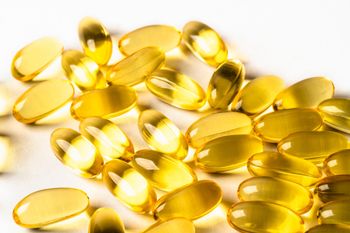
EU Panel Recommends Higher Omega-3 Intake for Pregnant and Nursing Women
Pregnant and nursing women should consume at least 200 mg of docosahexaenoic acid (DHA) per day, according to a new consensus statement by a committee of European experts. The committee included more than 50 members of the international Perinatal Lipid Nutrition Group (PeriLip) and the Early Nutrition Programming Project (Munich, Germany).
The consensus statement, which appears in the November 2007 issue of the British Journal of Nutrition, makes several recommendations to healthcare practitioners about the benefits of omega-3 long-chain polyunsaturated fatty acids (LC PUFAs). The European Union (EU) funded the four-year research program.
DHA is essential for the development of the brain, eye, and nervous system. It also plays an important role in cardiovascular health. Some research suggests that maternal intake of omega-3 fatty acids can result in higher birth weights and a lower risk of preterm delivery.
“We reviewed a wealth of evidence on the benefits of DHA and hope that our findings will offer clear guidance for healthcare professionals on the optimum DHA intake for women during pregnancy and nursing,” said lead author Berthold Koletzko, MD, a professor of pediatrics at the University of Munich, when the recommendations were publicly announced last August.
Some experts consider the amount of DHA in Western diets to be too low. While the human body can convert other omega-3 fatty acids-such as alpha-linolenic acid-into DHA, the process is inefficient and varies among individuals, according to the consensus statement authors.
“The fractional conversion of alpha-linolenic acid to omega-3 LC PUFAs may be greater in women than in men, which may contribute to meeting the demands of the fetus and the breast-fed neonate for DHA, but most evidence indicates that the overall contribution of alpha-linolenic acid to DHA is limited,” according to the consensus statement.
Cardiovascular Ingredient Combines Omega-3 and Vitamin K2
PL Thomas (PLT; Morristown, NJ) and Ocean Nutrition Canada (Dartmouth, NS, Canada) are collaborating on a new ingredient that merges the heart-healthy benefits of fish oil and vitamin K2.
The product, MEG-3 – MenaQ7 will offer 30% eicosapentaenoic acid (EPA), 20% docosahexaenoic acid (DHA), and 45 µg of vitamin K2 as menaquinone-7 (MK-7) per serving.
Studies suggest that the omega-3s EPA and DHA promote cardiovascular health. In addition, vitamin K2 may promote wellness by activating an inhibitor of vascular calcification known as matrix GLA protein (MGP), according to PLT.
“The many health benefits of EPA and DHA from fish oil are well recognized, and with this new offering, consumers specifically interested in cardiovascular health benefits will also receive natural vitamin K2 as MK-7, which is shown to further promote vascular health,” said Ocean Nutrition Canada president and CEO Robert Orr on November 5.
“We are delighted to partner with Ocean Nutrition, and we recognize its position as a market leader and innovator, providing the highest-quality, science-based nutritional products to the nutritional and functional foods marketplace,” added PL Thomas president Paul Flowerman.
Lack of Reference Values Hampers Omega-3 Claims
FDA issued a notice of proposed rule making in the November 27, 2007, Federal Register rejecting several nutrient content claims for omega-3 fatty acids. The agency said it hoped to prevent consumers from misinterpreting food labels and consuming either too much or too little omega-3.
In its notice, FDA said it will not allow nutrient content claims for docosahexaenoic acid (DHA) and eicosapentaenoic acid (EPA) but will permit some claims for alpha-linolenic acid (ALA). The nutrient content claims at issue characterized products as being “a good source of” or “high in” particular omega-3s.
“FDA has reviewed the information included in the three notifications and is proposing to prohibit the nutrient content claims for DHA and EPA set forth in the three notifications because they are not based on an authoritative statement that identifies a nutrient level to which the claims refer, as required by the controlling statutory authority,” the agency wrote.
According to FDA, the nutrient levels should be based on statements from official scientific bodies such as the Institute of Medicine (IOM) of the National Academy of Sciences (Washington, DC).
The agency filed the notice in response to notifications submitted between 2004 and 2006 from three seafood processors and two ingredient manufacturers: Alaska General Seafoods (Kenmore, WA), Ocean Beauty Seafoods (Seattle), and Trans-Ocean Products (Bellingham, WA); Martek Biosciences Corp. (Columbia, MD); and Ocean Nutrition Canada (Dartmouth, NS, Canada).
Noting that scientists have conducted hundreds of studies since IOM’s last major report on recommended nutrient intakes, the Global Organization for EPA and DHA Omega-3 (GOED; Salt Lake City) called for FDA or IOM to release an authoritative statement recommending a specific intake of omega-3s based on the latest research.
“Rather than prohibiting nutrient content claims for EPA and DHA because an old review of the science set no daily requirement, we believe there should be a proper examination of the current clinical science to set a level for EPA and DHA as vital nutrients for chronic disease prevention and nutrient deficiencies,” GOED executive director Adam Ismail said on November 27.
The authors added that in nonhuman primates, preformed DHA is “about an order of magnitude” more efficient as a source of neonatal DHA than alpha-linolenic acid. In humans, fetal DHA accretion reaches 30–45 mg per day during the last trimester of pregnancy.
The panel also said that DHA did not appear to produce adverse effects in dosages of up to 1 g per day in clinical trials. Women can obtain the recommended intake of DHA by eating one or two servings of fish per week or through supplements.
The panel also called for increased screening of dietary inadequacies during the first trimester of pregnancy.
“At the moment, there is limited awareness of the role of omegas in infant development,” said Stewart Forsyth, MD, medical director of Ninewells Hospital and Medical School (Dundee, UK). “Over the last 10 years, many studies have highlighted the importance of DHA omega-3 during pregnancy and nursing, and this EU Commission research has confirmed the benefits for unborn babies and for infant development. It is therefore crucial that expectant and new mothers understand the benefits of DHA omega-3 and consume the recommended intake of DHA during pregnancy and nursing.”
At least one manufacturer is already citing the new consensus statement as part of its marketing efforts. On November 14, 2007, Azur Pharma (Dublin, Ireland) launched Natelle Plus, a prescription prenatal vitamin supplement that contains DHA.
Azur Pharma is producing the supplement under a six-year license and exclusive supply agreement with Martek BioSciences Inc. (Columbia, MD), which manufactures the algae-sourced omega-3 ingredient life’sDHA. In a November 15 press release, Martek referred to PeriLip’s findings.
“We expect this innovative prenatal product, incorporating Martek’s patented technology, to become a leading product for pregnant women,” said Azur Pharma CEO and chairman Seamus Mulligan.
Because life’sDHA is derived from algae, it also may appeal to vegetarians and other consumers who want to avoid eating fish.
“Martek’s life’sDHA provides all the benefits of DHA omega-3 in a safe, vegetarian form, and we are pleased to be working with Azur to bring the unique benefits of life’sDHA to women through Natelle Plus DHA,” said Martek president David Abramson.
Newsletter
From ingredient science to consumer trends, get the intel you need to stay competitive in the nutrition space—subscribe now to Nutritional Outlook.





